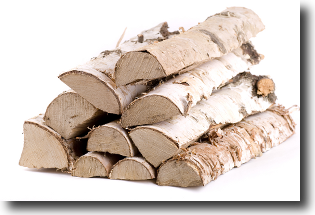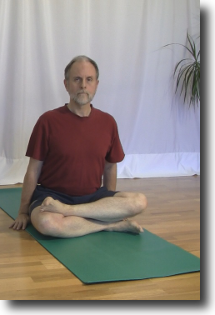Bob is visiting with Alice at her cottage when the pile of firewood beside the fireplace catches his attention. Just looking at the logs piled one on top of the other makes him think of his hips and the tightness there.
Bob is working on developing more flexibility in his hips and the pile of firewood reminds him of a pose that his teacher recently taught him. Its common English name is “fire log pose” and its Sanskrit name is Agnistambhasana.
Alice’s firewood is stacked a lot more neatly that Bob’s legs are when he is in this pose.
What is Agnistambhasana
This is one of the many seated poses that works on opening the hips by developing an external rotation in the thigh and hip joint.
External rotation of the thigh is when the top of the thigh rotates away from the center of the body. The top of the thigh moves outwards and down towards the floor.
Why do this pose
This pose helps to develop strong external rotation of the thighs in the hip joint. The more external rotation there is in the thigh the more that the knee joint will move to be parallel to the floor rather than perpendicular.
As the knee joint comes closer to being parallel to the floor then Padmasana or Full Lotus will be possible.
How to do Agnistambhasana – fire log pose
You start in Dandasana seated on the floor with your legs together straight out in front of you.
From here you bend your left knee out to the side on the floor and draw your left ankle towards your hip. You want to have your left shin parallel to the front of the mat. The sole of your foot will be perpendicular to the mat. Flex your foot by drawing your toes towards your knee.
Now you bring your right ankle on top of your left knee and lower your right knee down towards your left foot.
If you have the legs in the correct position you will have your right ankle on top of your left knee and your right knee will be above your left ankle.
This is where the pose gets its name. The shins stacked one above the other look like a pile of firewood.
Once you get the legs in position it is time to work on the torso. Sit tall with the top of your hips above your sitz bones. Engage Uddiyana Bandha, the lower abdominal muscle lock, lift your ribs and drop your shoulders down your back. These movements will ensure that you have a straight and tall torso.
After you have the legs in position and your torso setup you bring the top of your hips forward, taking the torso forward and down towards the floor. Eventually your head will rest on the floor with your arms on the floor beyond your torso.
Bob’s legs are not yet parallel to each other or to the floor. There are a few modifications that Bob can do with this pose to get his legs to look a little more like Alice’s neat pile of firewood.
Some Modifications
raise your hips
If your bottom knee is rising up off of the floor a lot you can raise your hips up by putting a support under your hips. You can use a folded blanket, foam or block under the hips.
Raising your hips off of the floor will require less external rotation in the thigh and will let the knees come closer to the floor.
As the flexibility in your hips improve and your thigh starts to externally rotate more and more you will find that you need less and less support under your hips. Over time reduce the thickness of the support under your hips and continue to challenge your thighs to externally rotate more and more.
support your lower knee
If your lower knee is rising up off of the floor a small amount you can put some support under the knee rather than under the hips. You can use a folded blanket, foam or block to support the knee. Over time as the flexibility of your hip increases you can reduce the thickness of the support under the knee and eventually the knee will rest on the floor.
Supporting the knee will help you to focus on the external rotation of the thigh in the hip.
manually rotate your thighs
Bring your hands to the top of your thighs with your thumbs on the inside and your fingers on the outside. Firmly hold on to your thighs and rotate them towards the outside by moving your hands out and down towards the floor. At the same time bring the top of your hips forward slightly.
This movement will help to develop the external rotation of your thighs.
Bob has made several of the common mistakes when he was learning this pose. These mistakes reduced the effectiveness of the pose and lessened the amount of external rotation that he can develop in the pose. Bob’s teacher helped him to correct these mistakes.
Common mistakes to watch out for
drop your hips back
To take pressure off of the hips some people let the top of their hips fall backwards away from the knees. This movement will result in the rounding of your lower back and could result in stress to your lower back muscles. As the top of the hips fall backward there is less external rotation in the thighs so the pose is becoming less effective.
You need to counteract this tendency by becoming aware of the placement of the top of your hips. Make sure that the top of your hips are above your sizt bones and that you are sitting tall with a long spine.
Bottom ankle towards your hip
Sometimes the bottom ankle will be closer to the hip than to the knee. This movement will require less external rotation in the thigh and will allow your knees to come closer to the floor. While it is good to get the knees closer to the floor, the purpose of the pose is to develop external rotation in the thighs.
When you notice that the lower ankle is not under the upper knee you need to move the ankle forward under the knee. This movement will increase the amount of external rotation required in the thigh.
Top ankle on your shin
To take pressure off of the hip and thigh there is a tendency to let the top foot slide off of the lower knee and down the shin. While this movement will let the shins become parallel and look like a pile of fire wood this is not the goal of the pose.
Bring the top ankle back on top of the knee even if the top knee rises up off of the lower ankle.
Summary
Bob’s legs are beginning to look more and more like that pile of firewood neatly stacked beside Alice’s fireplace.
With patience and regular practice you will find that your legs will look like a pile of firewood as well.
Next Step
Work with your teacher to learn this pose. They can help you with the modifications that you may require and help you to avoid the common mistakes that will reduce the benefits of this pose.





